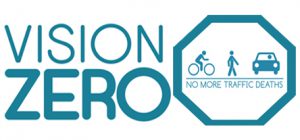Leah Shahum, the founder and director of the Vision Zero Network, discusses in a webinar the importance of traffic safety through the initiative of Vision Zero. Vision Zero is a project with the goal of zero traffic injury among all street users, including those walking, driving, or biking. This focuses on traffic safety with a public health approach to provide individuals with safe streets to move around on. Motor vehicle deaths are currently higher than firearms deaths, which is surprising due to the lack of traffic violence in the news and media. 38,000 people lost their lives on the streets last year due to vehicle-related incidents, so it is time to address this issue and make people aware that we are able to control the safety of our streets.
Of course there is no way to prevent all traffic accidents, but many factors often play into why a crash occurred, and it is not always just an accident. For example, it could be related to engineering problems, individual behaviors, or other preventable measures. Two important aspects of crashes that were addressed in the webinar were related to speed and engineering problems. Factors addressing speed issues are simply setting appropriate speed limits, enforcing them, and proper sign placement to make the streets safer. The base of making the streets safer also begins with engineering. Some ways to improve engineering could be having more sidewalks, wider bike lanes, and more space between the road and sidewalk. To do this, an entire community must get involved such as the mayor’s office, police force, and the public health department. It is a team effort focused on measurable goals to bring safety to a community.
Vision Zero has been effective in major cities across the United States, including Fort Lauderdale, Washington, D.C., and New York City with lower traffic-related death rates as Vision Zero has been implemented. Because of the success in major cities, it would also be useful to use this project in smaller communities and suburban areas as well. No one should be in danger or fearful simply moving around one’s own community. Health practitioners and professionals encourage people to get outside and be active through walking, running, or biking, but to do this effectively, policies like Vision Zero need to be in the environment to provide overall street safety. Practitioners can use this information to influence policy and legislation, promote community education, and change the practices of the community to put Vision Zero into action. Public health professionals can also encourage individuals to be aware of their surroundings when out on the streets, such as looking both ways before crossing and limiting cell phone use. For more information on taking action and an individual’s role in traffic and street safety, http://www.nyc.gov/html/visionzero/pages/home/home.shtml is a useful source.

I like the aspect of this initiative because it puts equal emphasis on drivers, bikers, and motorists. Usually one is pitted against each other. Regardless of our means of transportation, we all need to realize we have responsibility for traffic safety. Another nice thing about the program is that it is a joint effort between a variety of municipal organizations ranging from the Department of Health and Mental Hygiene to the Taxi and Limousine Commission.
The built environment plays an important role in how we commute along with perceptions of safety among commuters. One issue that has risen due to this initiative is oversimplifying what’s considered “good” for the community. For example, in Washington DC, there has been tension between the long-term residents(senior citizens) and the new(and younger)residents regarding bike lanes. While the new residents want more bike lanes, the long-term residents do not see bike-lanes to be relevant to their commuting needs. We must be cognizant that there are different needs for different communities when it comes to making the streets more safe.
Built environment is truly one of my favorite topics. It is so interesting how all of these aspects come into play especially when looking at health outcomes of a community. I definitely agree that if health professionals are telling people to go outside and get exercise, then the least the community should do is provide the safe places to do so. However, I am curious as to how these changes actually affect the health of these communities. You mention that Vision Zero has been implemented in many cities, but have BMI and physical activity levels been assessed pre- and post-intervention? While this program may be successful at reducing accidents, is it having any effect of the health of the community, positive or negative? If safety was not a barrier to physical activity before, then there might not be any change in the communities’ health. These are questions that need to be looked into when making any sort of built environment change (for health reasons) and it will definitely vary from city to city. However, overall, reduction in accidents and increase in safety is a very great achievement for this company.